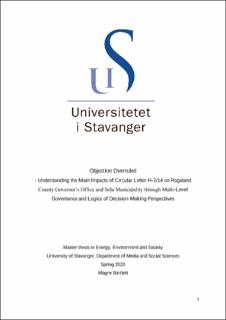| dc.contributor.advisor | Holmen, Ann-Karin Tennås | |
| dc.contributor.author | Bartlett, Magne | |
| dc.coverage.spatial | Norway | en_US |
| dc.date.accessioned | 2020-11-16T11:38:10Z | |
| dc.date.available | 2020-11-16T11:38:10Z | |
| dc.date.issued | 2019-06-15 | |
| dc.identifier.uri | https://hdl.handle.net/11250/2688007 | |
| dc.description | Master's thesis in Energy, Environment and Society | en_US |
| dc.description.abstract | When the Solberg Coalition Government consisting of the Conservative Party and the Progress Party assumed power in 2013, they expressed a wish to limit the County Governors opportunity to overrule local self-governance in spatial planning matters. In February 2014 Circular Letter H-2/14 was introduced with focus on limiting the number of objections, making objections better justified and increased consideration for local self-governance in deciding on objections. Reports show that the number of objections has decreased, but how has Circular Letter H-2/14 impacted the relation between actors on the local level? The main question of this thesis is therefore:
How can we understand the main impacts of circular letter H-2/14 for the Objection Institute in the relation between the County Governor in Rogaland’s Office and Sola Municipality?
From a governance perspective, findings show that Circular Letter H-2/14 has created a new legal custom in the Ministry of Local Government and Modernization, placing great emphasis on considerations for local self-governance. This has led to municipalities getting a significantly higher percentage of decisions on objections appealed to the Ministerial level decided in their favor. Through the center – periphery dimension of power provided by the Multi-Level Governance perspective the thesis concludes that there has been a decentralization in the power relation, shifting the power balance in Sola Municipality’s favor.
The thesis uncovers Mediation Meeting procedures for Rogaland. Findings show that Rogaland has a custom for Discussion Meetings prior to mediation meetings where most objections are solved. Only 1-5 % of objections are mediated over. Findings also show that the logics of decision-making applied vary according to the design of the negotiation arena and the level of conflict within individual objections. Deliberation and Deliberative Negotiation are the most prevalent in Discussion Meetings, while Deliberative Negotiation and Strategic Bargaining are most prevalent in Mediation Meetings.
The thesis concludes that the integrity of the Objection Institute might be compromised based on the presented findings and recommends a revision of the Plan and Building Act. | en_US |
| dc.language.iso | eng | en_US |
| dc.publisher | University of Stavanger, Norway | en_US |
| dc.relation.ispartofseries | Masteroppgave/UIS-SV-IMS/2020; | |
| dc.rights | Navngivelse-DelPåSammeVilkår 4.0 Internasjonal | * |
| dc.rights.uri | http://creativecommons.org/licenses/by-sa/4.0/deed.no | * |
| dc.subject | spatial planning | en_US |
| dc.subject | governance | en_US |
| dc.subject | county governor | en_US |
| dc.subject | municipality | en_US |
| dc.subject | multi-level governance | en_US |
| dc.subject | norsk politikk | en_US |
| dc.title | Objection Overruled - Understanding the Main Impacts of Circular Letter H-2/14 on Rogaland County Governor’s Office and Sola Municipality through Multi-Level Governance and Logics of Decision-Making Perspectives | en_US |
| dc.type | Master thesis | en_US |
| dc.subject.nsi | VDP::Samfunnsvitenskap: 200::Statsvitenskap og organisasjonsteori: 240 | en_US |

